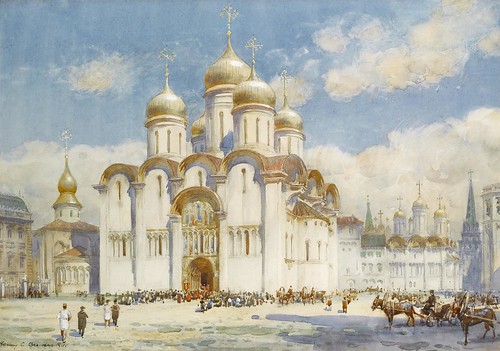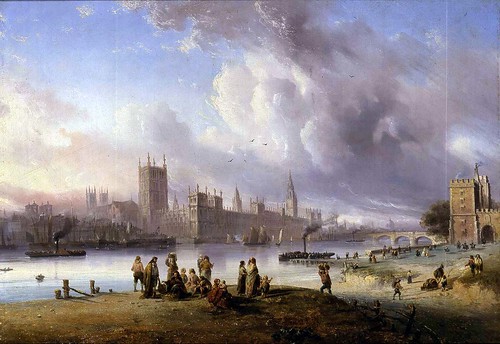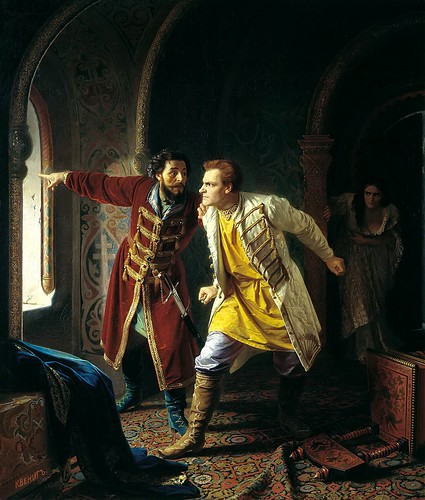The painting is one of the earliest of Guardi's works as a view painter, probably dating from about 1760. It shows the most famous of Venetian squares, the Piazza San Marco, with the medieval cathedral and its bell tower in the background and the 16th-century public offices, the Procuratie Vecchie, left, and the Procuratie Nuove, right, with shops and cafés to each side. In Guardi's painting figures and architecture are more freely handled than was customary with Canaletto, and the crowd that idles in the Piazza is given greater prominence.
[Oil on canvas, 72.4 x 119.1 cm]
![Francesco Guardi - Venice: Piazza San Marco [c.1760] by Gandalf's Gallery](http://farm8.staticflickr.com/7221/7031512557_bc9d53b643.jpg)
![Charles-François Daubigny - St Paul's from the Surrey Side [1871-73] by Gandalf's Gallery](http://farm8.staticflickr.com/7131/7031510431_6d9a662abc.jpg)
![Pierre-Cecille Puvis de Chavannes - Summer [before 1873] by Gandalf's Gallery](http://farm7.staticflickr.com/6093/7028868245_1359d0f3a5.jpg)
![Lionel Bulmer - Footpath in the Snow [1954] by Gandalf's Gallery](http://farm7.staticflickr.com/6058/6882767356_cedd5fbf32.jpg)
![Edgar Degas - Horses in a Meadow [1871] by Gandalf's Gallery](http://farm8.staticflickr.com/7090/7026155069_b0007cd460.jpg)
![Edouard Manet - A King Charles Spaniel [c.1866] by Gandalf's Gallery](http://farm8.staticflickr.com/7051/6880054392_a9325bd5bf.jpg)
![Edouard Manet - Flowers in a Crystal Vase [c.1882] by Gandalf's Gallery](http://farm8.staticflickr.com/7271/7023310081_f0b969568e.jpg)
![Pieter Claesz - Still Life with Drinking Vessels [1649] by Gandalf's Gallery](http://farm8.staticflickr.com/7269/6877210304_b3dea5c03c.jpg)
![Pieter de Hooch - A Dutch Courtyard [1658-60] by Gandalf's Gallery](http://farm8.staticflickr.com/7128/7020187173_b68365d92a.jpg)
![Jan Brueghel & Peter Paul Rubens - The Garden of Eden [c.1615] by Gandalf's Gallery](http://farm8.staticflickr.com/7197/7020189361_3426a7d541.jpg)
![Jan Toorop - The Sea [1887] by Gandalf's Gallery](http://farm8.staticflickr.com/7118/6870831396_f1556b1f51.jpg)
![Alfred William Finch - The Channel at Nieuport [c.1889] by Gandalf's Gallery](http://farm8.staticflickr.com/7187/6870830872_a0e392dacb.jpg)
![Albert Bettanier - The Black Spot [1887] by Gandalf's Gallery](http://farm8.staticflickr.com/7246/7013487873_d7bf63db18.jpg)
![Gabriel Metsu - The Sick Child [c.1660-65] by Gandalf's Gallery](http://farm8.staticflickr.com/7224/6867376696_2ab4a22804.jpg)
![Harmen Steenwyck - Still Life, An Allegory of the Vanities of Human Life [c.1640] by Gandalf's Gallery](http://farm8.staticflickr.com/7049/7010579609_f03a0c37b6.jpg)
![Jan Sanders van Hemessen - Allegorical Scene [c.1550] by Gandalf's Gallery](http://farm8.staticflickr.com/7264/7010579817_e7be694eae.jpg)
![Hans Bol - River Landscape [1578] by Gandalf's Gallery](http://farm8.staticflickr.com/7255/7007968931_357a80af92.jpg)
![Antonio Mancini - The Customs [1877] by Gandalf's Gallery](http://farm8.staticflickr.com/7128/6861853734_ee50e42f6a.jpg)
![Henri Rousseau - Surprised! [1891] by Gandalf's Gallery](http://farm8.staticflickr.com/7060/6859238126_f5dd743435.jpg)
![Vincent van Gogh - Sunflowers [1888] by Gandalf's Gallery](http://farm8.staticflickr.com/7233/7005355445_4fd898c92b.jpg)

![Honore Daumier - Amateur of Prints [1860] by Gandalf's Gallery](http://farm7.staticflickr.com/6043/6856273782_fc6660083a.jpg)
![Peter Paul Rubens & Jan Breughel the Elder - The Feast of Acheloüs [c.1615] by Gandalf's Gallery](http://farm8.staticflickr.com/7241/6999606889_4041f04922.jpg)
![Andrea Celesti - The Feast of Belshazzar [1705] by Gandalf's Gallery](http://farm8.staticflickr.com/7196/6999606647_2ed399f6e8.jpg)
![George Glenn Newell - Twilight [c.1905] by Gandalf's Gallery](http://farm8.staticflickr.com/7225/6996149337_664b6e2da3.jpg)
![Thomas Luny - Unloading the Catch [1829] by Gandalf's Gallery](http://farm8.staticflickr.com/7225/6996149979_6b95bca89f.jpg)

![Alfred Sisley - The Church of Moret, Evening [1894] by Gandalf's Gallery](http://farm8.staticflickr.com/7064/6846190184_be1135d683.jpg)
![Aimé Morot - The Good Samaritan [1880] by Gandalf's Gallery](http://farm8.staticflickr.com/7205/6989449397_985b2f8d78.jpg)
![Mikhail Klodt von Jurgensburg - Under the Birch Trees [1874] by Gandalf's Gallery](http://farm8.staticflickr.com/7058/6989449631_dc0a79d1ca.jpg)
![Konstantin Gorbatov - Windmills [1911] by Gandalf's Gallery](http://farm8.staticflickr.com/7067/6986776653_c9ff7a0548.jpg)
![Jacob Ochtervelt - Two Women and a Man Making Music [c.1675-80] by Gandalf's Gallery](http://farm8.staticflickr.com/7070/6986776251_9c13834096.jpg)
![Georges Manzana-Pissarro - Bridge at Saint Cloud Under Snow [1905] by Gandalf's Gallery](http://farm8.staticflickr.com/7060/6984265027_c29d1fbf37.jpg)
![Alfred Sisley - Bridge At Villeneuve-La-Garenne [1872] by Gandalf's Gallery](http://farm8.staticflickr.com/7179/6838143792_42317ff723.jpg)
![John Pike - Village Green [1945] by Gandalf's Gallery](http://farm8.staticflickr.com/7209/6981606087_3014b11aae.jpg)
![Anders Zorn - Wet [1910] by Gandalf's Gallery](http://farm8.staticflickr.com/7055/6981606381_9d66778c3f.jpg)

![Francesco Guardi - View of the Venetian Lagoon with the Tower of Malghera [c.1770s] by Gandalf's Gallery](http://farm8.staticflickr.com/7040/6832570014_e3af488e74.jpg)
![Max Liebermann - Women Plucking Geese [1872] by Gandalf's Gallery](http://farm8.staticflickr.com/7209/6829443734_d500ba18b6.jpg)

![Aristide Maillol - Two Nudes within a Landscape [1895] by Gandalf's Gallery](http://farm8.staticflickr.com/7198/6972039083_5440a7f53a.jpg)
![Aristide Maillol - Two Women Wearing Hats within a Landscape [1895] by Gandalf's Gallery](http://farm8.staticflickr.com/7064/6972040231_ac31ca38c9.jpg)
![Hans Thoma - Summer [1872] by Gandalf's Gallery](http://farm8.staticflickr.com/7180/6822812418_21c2ccceff.jpg)

![Garofalo - The Agony in the Garden [c.1520-39] by Gandalf's Gallery](http://farm8.staticflickr.com/7046/6966412705_70b40ac0d4.jpg)
![Studio of El Greco - The Agony in the Garden of Gethsemane [1590s] by Gandalf's Gallery](http://farm8.staticflickr.com/7184/6820293890_aac763a0f4.jpg)
![Gwen John - Corner of the Artist’s Room in Paris [1907] by Gandalf's Gallery](http://farm8.staticflickr.com/7055/6817698414_b16aa450f2.jpg)
![Charles Guerin - Nude [c.1910] by Gandalf's Gallery](http://farm8.staticflickr.com/7201/6963822305_567322cafe.jpg)
![The Boulevard Saint-Denis in Paris [1899] by Gandalf's Gallery](http://farm8.staticflickr.com/7176/6815153546_7ee2ec7d94.jpg)